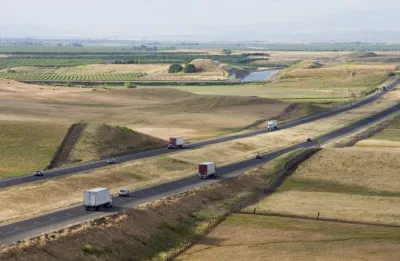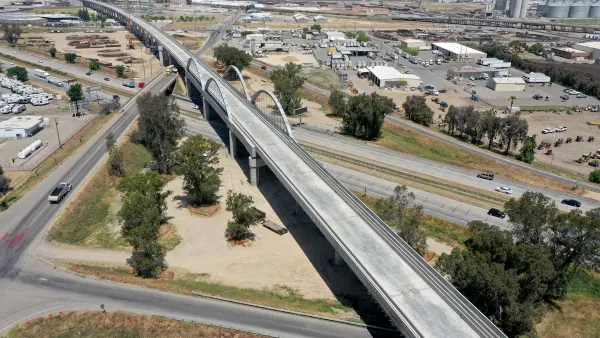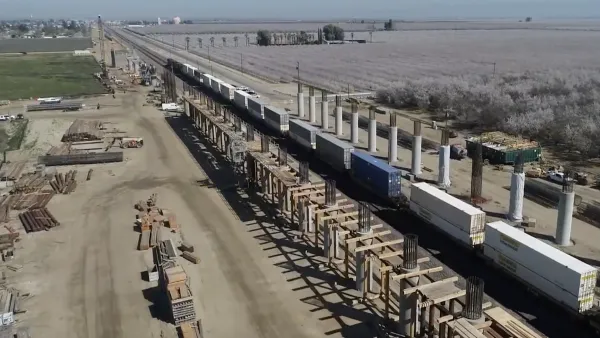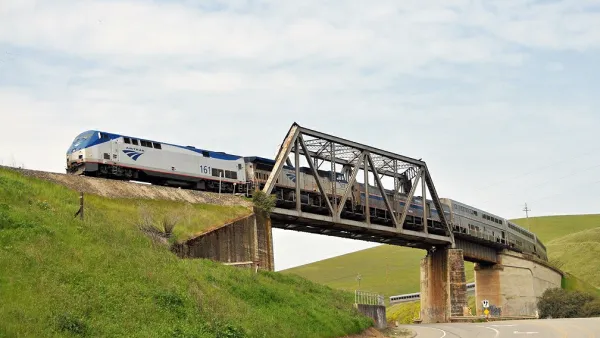The cost increases and delays on the Central Valley project have some state lawmakers wondering whether funds should go toward local transit systems instead.

"Thirteen years since California voters approved $10 billion to build a bullet train," writes Marissa Garcia, "Democrats who run the state government are divided over spending the money to finish building the first section of track — a 119-mile stretch in the Central Valley."
Some wonder whether the funds would be better spent expanding urban transit in more heavily populated regions. Ethan Elkind, director of the climate program at the UC Berkeley School of Law, says starting the project in the Central Valley was unusual. "Typically what you’d see with projects like this is they’d start where the people are at and then radiate outwards. So, we would have started building high-speed rail in the San Francisco Bay Area, down in LA, and then eventually connect it," Elkind told CalMatters.
"The Newsom administration, however, praises high-speed rail as a job creator in the economically-struggling Central Valley." But "[k]ey lawmakers, especially in the Assembly, say they don’t see the benefit for their Southern California constituents. And even if the bullet train eventually reaches Los Angeles and San Francisco, some legislators are skeptical that car-centric Californians will become train riders without more exposure to public transit in their daily lives."
Assembly Transportation Committee chairperson Laura Friedman questioned the value of spending additional billions on the Central Valley train. "With a quarter of California’s population living in Los Angeles County, Friedman would like to see money spent on improving Union Station in Los Angeles, the Metrolink commuter rail and transit between the San Fernando Valley and LA’s Westside." She argues that "better local service will boost support for trains, eventually restoring voters’ favor for high-speed rail."
"A poll funded by the Assembly Democrats found that Californians are evenly split between killing high-speed rail or continuing it, but that support for the project is far higher among Democrats, the San Francisco Chronicle reported."
FULL STORY: Bullet train budget battle: Should California spend more on urban transit, not high-speed rail?

Analysis: Cybertruck Fatality Rate Far Exceeds That of Ford Pinto
The Tesla Cybertruck was recalled seven times last year.

National Parks Layoffs Will Cause Communities to Lose Billions
Thousands of essential park workers were laid off this week, just before the busy spring break season.

Retro-silient?: America’s First “Eco-burb,” The Woodlands Turns 50
A master-planned community north of Houston offers lessons on green infrastructure and resilient design, but falls short of its founder’s lofty affordability and walkability goals.

Test News Post 1
This is a summary

Analysis: Cybertruck Fatality Rate Far Exceeds That of Ford Pinto
The Tesla Cybertruck was recalled seven times last year.

Test News Headline 46
Test for the image on the front page.
Urban Design for Planners 1: Software Tools
This six-course series explores essential urban design concepts using open source software and equips planners with the tools they need to participate fully in the urban design process.
Planning for Universal Design
Learn the tools for implementing Universal Design in planning regulations.
EMC Planning Group, Inc.
Planetizen
Planetizen
Mpact (formerly Rail~Volution)
Great Falls Development Authority, Inc.
HUDs Office of Policy Development and Research
NYU Wagner Graduate School of Public Service




























